WARNING: The potato leafhopper is here. The numbers are small so far, but keep your eyes open. Remember, it is very important to scout for the insect. If you wait to see the damage, you waited too long. See the May 29, 2018 issue of the Pest Report for the whole story about potato leafhopper.
In this issue:
Striped Cucumber Beetle
Early Blight
Thrips on Onions
Three Lined Potato Beetle
Imported Cabbage Worm
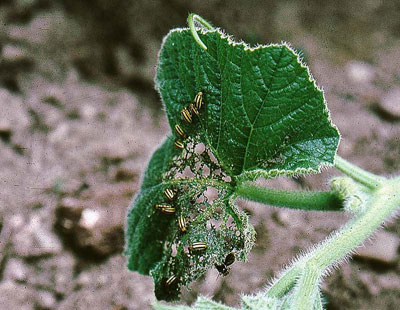 |
| Cucumber beetles. Photo by Eric Sideman. |
STRIPED CUCUMBER BEETLE
Striped cucumber beetle is our most serious early-season pest in vine crops. These beetles spend the winter in plant debris in field edges and with the onset of warm days and emergence of cucurbit crops they move rapidly into the field. Densities can be very high, especially in non-rotated fields or close to last year’s cucurbit crops. Adult feeding on cotyledons and young leaves can cause stand reduction, delayed plant growth, and reduced yield. The striped cucumber beetle also vectors Erwinia tracheiphila, the causal agent of bacterial wilt, and this can be more damaging than direct feeding injury. Crop rotation, transplants, and floating row cover are cultural controls that help reduce the impact of cucumber beetles. Many growers use row covers on cucurbits for both growth benefit and insect protection, and remove when flowering begins. I remove the covers when I see the first female flower.
Perimeter trap cropping with a preferred cucurbit crop (usually a C. maxima such as blue Hubbard or buttercup) can give excellent control with a dramatic reduction in pesticide use. For details on using perimeter trap cropping, see CT IPM Integrated Pest Management Program’s Directions For Using a Perimeter Trap Crop Strategy to Protect Cucurbit Crops
Avoid early season infection with wilt. Cucurbit plants at the cotyledon and first 1-2 leaf stage are more susceptible to infection with bacterial wilt than older plants, and disease transmission is lower after about the 4-leaf stage. Using row covers at this most vulnerable stage to keep the beetles out can be very effective.
Thresholds and foliar controls. Beetle numbers should be kept low, especially before the 5-leaf stage. Scout frequently (at least twice per week before emergence, and for two weeks after crop emergence) and treat after beetles colonize the field. The threshold depends on the crop. To prevent bacterial wilt in highly susceptible crops such as cucumber, muskmelons, summer squash, and zucchini, we recommend that beetles should not be allowed to exceed one beetle for every 2 plants. Less wilt-susceptible crops (butternut, most pumpkins) will tolerate 1 or two beetles per plant without yield losses. Spray within 24 hours after the threshold is reached.
Insecticides that are allowed in organic production (listed by OMRI, the Organic Materials Review Institute, www.omri.org) include kaolin clay (Surround WP), pyrethrin (Pyganic Crop Spray 5.0 EC), and spinosad (Entrust). In 2009 UMass spray trials comparing these three products at the UMass Research Farm, kaolin was the most effective in reducing beetle numbers and feeding damage. There was a trend toward Surround WP being more effective when Pyganic or Entrust was mixed with it, but never significantly better than Surround alone. Surround should be applied before beetles arrive because it acts as a repellent and protectant, not a contact poison. With direct-seeded crops, apply as soon as seedlings emerge if beetles are active. Transplants can be sprayed or dipped before setting out in the field.
(Modified from the UMass. Vegetable Newsletter, original written by Ruth Hazzard & Andrew Cavanagh)
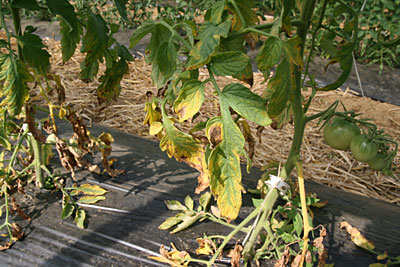 |
| Early blight on tomato |
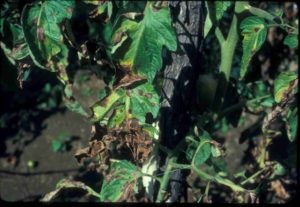  |
| Another view of early blight on tomato |
EARLY BLIGHT ON TOMATO (Alternaria solani)
Early blight is a serious problem in tomatoes and potatoes, but rarely affect peppers and eggplants. In most years, it is very common; much more common than late blight, which is usually rare in Maine any where other than the County. All aboveground portions of the plant can be affected throughout the growing season. The disease starts on the lower leaves with small, circular spots that resemble a target with their concentric rings. Leaves develop yellow blighted areas, eventually turn all yellow and die. The tomato fruit may rot on the stem end. Though rare, potato tubers can also become infected. The pathogen overwinters on diseased plant residues in the soil. Initial infection is from splashing up from this overwintering site. BUT, by mid summer, most of the infection is coming from spores blowing in the wind from the widespread infection in gardens and on farms across the region. It is important to avoid early on-set of the disease because the longer you can avoid the problem the more likely it is that you will harvest red tomatoes before the plants die. Here are some cultural practices that can help avoid this disease.
Use crop rotations of at least three years to non-hosts (i.e., away from tomato, potato, and eggplant). Once the plant residue decays, the pathogen is gone.
Provide optimum growing conditions and fertility. Stressed plants (including drought or excessive moisture or shade) are more susceptible to early blight.
Stake or cage plants to keep fruit and foliage away from soil, and promote quicker drying.
Drip irrigation is preferred. If using overhead irrigation, start before dawn, so plants are dry early in the day. The key is to keep the period of leaf wetness to a minimum.
Mulching helps to prevent splashing of spores from soil up to lower leaves.
Indeterminate tomato and late-maturing potato varieties are usually more resistant or tolerant to early blight.
Early blight can be seed-borne, so buy from a reliable supplier. Hot water seed treatment at 122°F for 25 minutes is recommended to control early blight on tomato seed.
Each season, disinfect stakes or cages with an approved product before use. Sodium hypochlorite at 0.5% is effective and must be followed by rinsing and proper disposal of solution. Hydrogen peroxide is also permitted.
Grow tomatoes in a high tunnel or caterpillar tunnel. Tomatoes grown with such protection rarely suffer from early blight because there is less splashing and wind blown spores and the leaves are drier.
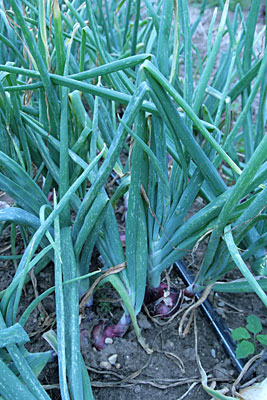 |
| Damage to onion leaves caused by thrips. |
ONION THRIPS
Onion thrips may be active already, and if they have been a problem for you in years past it is time to start scouting for them. They are very tiny and easily overlooked until the onion plants start showing leaves that look as if they have been rasped. In fact they have. The thrips feed by using their moth parts to rasp and pierce the onion leaves, releasing juices for them to feed upon. If the population of thrips is large you will see silvery patches on all the young leaves and when really bad the whole field will look white and silvery and the leaves wither. Obviously onion yields can be greatly reduced because the onion plants loses food and water through the damaged tissue. It is best to get control of them now before the populations grow.
Onion thrips hide between the leaves at the base of the onion plant. I find the best way to find them is to pull up a plant and hold it upside down over a white sheet of paper and pull apart the leaves as you shake gently. Even when they are walking about on the paper you will still need to look hard to see the thrips. My eyes are not that good and I need a hand lens to even spot them. The immature thrips are white to a pale yellow, elongated with very short antennas and dark eyes. Remember, tiny. The adult is tiny too, but it has wings. Thrips’ wings are unique. They are fringed with hairs. Thrips are very poor fliers, but they do fly when disturbed, and they do get blown in the wind easily, so they may move long distances. Keep in mind that this means thrips will be blown to new fields downwind. Adults are pale yellow to dark brown.
There are many generations per season and they can be very quick in warm weather. Also, parthenogenesis is common, meaning females that cannot find males produce progeny all by themselves. Each female can produce up to 80 eggs, which tells you that the population can explode quite quickly under good conditions. Good conditions are warm and without heavy rains. Heavy rains wash the weak insect off the plant.
Growers can simulate heavy rains with heavy overhead irrigation. As well as disturbing the insect, the extra water will help the rasped onions. Extra fertilization will help too.
Thrips survive in onion and garlic debris so clean up after harvest. Also, thrips hide in the garlic bulb for the winter, so you may have “planted” them when you plant the garlic in the fall. I have heard that thrips are confused by inter-cropping with carrots.
If the natural enemies or the cultural practices fail to keep thrips populations down then you may need to turn to a pesticide. Remember, thrips are often around in small numbers which can be tolerated. IPM practices recommend an economic threshold of an average of 3 thrips per green leaf. When scouting, sample about 50 plants around the field from at least 10 different locations in the field and then figure the average per leaf. Entrust is the most common recommended material. Follow the label instructions and be sure to spray into the leaf axis. Surround is reported to deter thrips, and may be the better choice if you have had bad thrips problems in the past. See the summer 2013 edition of The Maine Organic Farmer & Gardener for an excellent article about onion thrips by Tom Vigue.
 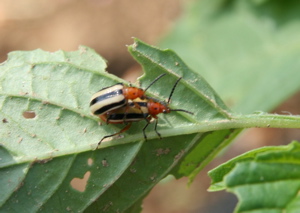 |
| Three-lined potato beetles. Photo by Eric Sideman. |
THREE-LINED POTATO BEETLE
Cucumber beetles on my potatoes and tomatillo?
No. Those are not cucumber beetles. Potatoes, tomatoes and sometimes eggplants are attacked by the three-lined potato beetle that only superficially looks like a cucumber beetle. The adult of this pest is about the same size as a cucumber beetle but has a reddish head and a thorax with two dark spots. The wing covers are dark yellow with three black stripes. Its favorite food in my experience is tomatillo.
The Three-Lined Potato Beetle overwinters as an adult and wakes early in the spring. They are there waiting for you to plant your solanaceous crops. The females soon begin laying eggs that hatch in about two weeks to larvae that look a bit like Colorado potato beetle larvae, except these critters have the endearing practice of carrying a small pile of their own excrement on their back. The larvae mature in about two weeks. There are probably two generations per year
On most crops the level of the pest does not warrant control. If this pest has been a problem in the past, floating row covers will help you avoid the overwintering adults and that should get you by. Hand picking will work on small plantings. Pyganic and Entrust may offer some relief. Rotenone works well, BUT REMEMBER THAT THERE ARE NO ROTENONE FORMULATIONS THAT MEET ORGANIC STANDARDS. IN FACT, ROTENONE IS NO LONGER A REGISTERED PESTICIDE AT ALL.
 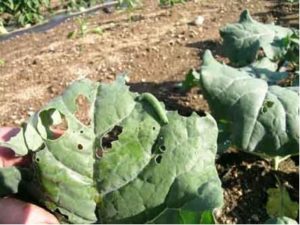 |
| Imported cabbage worm |
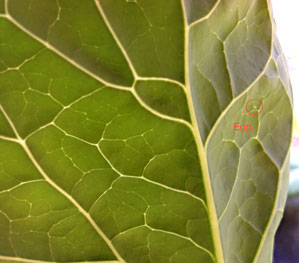 |
| Cabbage worm egg, circled in red. |
IMPORTED CABBAGE WORM
The white butterfly with the dark marks on its wing that are flying in large numbers around the vegetables is a troubling sight. They are very numerous this year. Becky can find the eggs they lay, and the tiny caterpillars that hatch. I only notice them after I see the holes and chunks chewed out of the leaves. It is much better to spot them early, so scout often. Even if you cannot see the eggs, it is much easy to manage tiny caterpillars.
The pest overwinters as a pupa in crop debris and is a common pest every year.
The imported cabbage worm is the most common of the three different caterpillars often found feeding on cabbage, broccoli, Brussels sprouts, kale, etc. The other two caterpillars often seen feeding on brassica crops are the diamondback moth and the cabbage looper. The looper does not overwinter in the north, and any overwintering of the diamondback is spotty at best. These pests are carried up here with storms. Hence problems from these pests vary from year to year, and are usually less common than the imported cabbage worm.
All three pests produce multiple generations each growing season. It is important to destroy the crop debris after harvest so as not to harbor future generations that will move onto your later plantings. Controlling cruciferous weeds will help. Row covers will work however these crops do not do well in heat so there could be problems.
Bt gives good control of all three caterpillars. Dipel is a common brand. But, as usual, if you are a certified grower be sure that the formulation you use is approved for organic production. Spinosad works even better, but is more expensive. Be sure to scout the crops and spray only when the pest is present. Bt must be eaten to work and since it degrades quickly in sunlight it should be sprayed when the pest is actively feeding. There is no protective activity.
By the way, the imported cabbage worm also feeds on lettuce.
